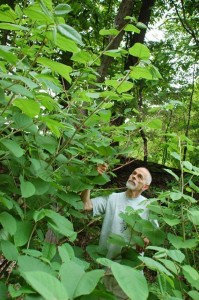By Janet Allen

John Allen marveling at the luxurious growth of a large patch of knotweed along a road near our home in Syracuse, NY. Each time we pass this knotweed stand, we remark on its continuing growth and, so far, unchallenged spread along more and more of the roadside.
My husband, John, has an enemy – a persistent, aggressive one, taller than he is – up to 10 feet or more. After battling this foe on our church grounds for an entire summer, he believes he may be conquering it, albeit slowly. That enemy is Japanese knotweed (Polygonum cuspidatum, or Reynoutria japonica) also known as fleece flower, crimson beauty, Mexican bamboo, or reynoutria. Those who know it most intimately call it “killer bamboo.”
Japanese knotweed was introduced from East Asia to the United Kingdom as an ornamental plant in the early 1800s, and from there to the United States in the late 1800s. Despite its “bamboo” characterization, it’s actually a member of the buckwheat family. This upright, shrub-like perennial has smooth stems, swollen at joints where the leaf meets the stem. Its large leaves are somewhat heart-shaped. Its sprays of tiny greenish-white flowers in summer are followed by small winged fruit containing lots of tiny seeds.
Japanese knotweed has invaded disturbed areas of the eastern U.S., some Midwest and western states, and even Alaska. It tolerates a wide variety of conditions, including full shade, high temperatures, and high salinity. Although it tolerates drought, it’s often found near water sources.
It spreads primarily by rhizomes, but it can also spread by water- or wind-borne seeds. It can even sprout from discarded cuttings. It spreads quickly and crowds out native vegetation, even more aggressively than most invasives. It’s extremely persistent. And it’s tough, having been known to push up through pavement or disrupt house foundations. It greatly alters native ecosystems.
Knowing what a nasty plant this is, imagine our horror when we saw it featured in a garden tour a few years ago! A professional landscaper had actually installed this monster – and some garden center had actually sold it! Any of the native alternatives listed in the sidebar would have been at least as beautiful in that landscape.
The USDA’s National Invasive Species Information Center offers an online video at invasivespeciesinfo.gov/plants/knotweed.shtml. (Oddly, the video features Gabriel Fauré’s lovely Pavane as background music; Paul Dukas’ Sorcerer’s Apprentice would have been more appropriate.)
Eradicating knotweed
There are many ways to attempt to eradicate knotweed. A brief overview of some methods is described below, but if you’re preparing for battle this year, it would be wise to further explore the details as you plan your attack. You probably will need to use more than one of these methods and definitely over a long period of time. As one commentator put it, “Prepare to make its eradication your new hobby.” And remember, cuttings can regenerate, potentially spreading the problem beyond your yard, so regardless of the methods you use, thoroughly dry or burn any stalks or rhizomes prior to disposal.
Smothering is one approach. Cut down all the old canes, and cover the patch with a large, sturdy tarp or overlapping tarps. This method has the virtue of being organic and also offering the possibility of gardening in raised beds right on top of the tarps. You might as well garden on top of them. Research suggests that rather than dying, knotweed has the capability of going dormant for up to 20 years or possibly longer.
Another method is to apply glyphosate as a foliar spray in late summer or early fall – or even repeatedly throughout the growing season to slow it down.
A third method is to dig out the rhizomes, attempting to get every bit, since it can resprout from even the smallest piece left in the ground. Of course, it’s not likely you’ll get every bit since the rhizomes of an established stand can spread 12-15 feet and 6-9 feet deep. Some advise against this method since—besides being a lot of work—it spreads the rhizome fragments and disturbs the soil, making it easier for new knotweed to get established.
A local nature center appears to have had some success with another method. They immediately cut down any emerging sprouts throughout the entire growing season, with the goal of starving it to death.
Inspired, my husband faithfully traveled to church with his scythe each week last summer. He scouted for each new sprout popping up and chopped off its little head. As doubts crept in toward the end of summer, he escalated the battle, carefully applying glyphosate on the cut stems.
He has engaged his enemy on the church ground battlefield again this year, (somewhat) confident of eventual victory. And he has changed his method. Instead of cutting down emerging shoots, he’s pulling them out. He claims the knotweed is much less vigorous this year than last and predicts that after this year, he’ll need only to monitor the area occasionally. In fact, he’s already making plans to use this reclaimed area for native plants.
Who will win – my husband or the killer bamboo? Wifely loyalty demands that I bet on my husband, but more objective onlookers may have doubts. Poor guy. I’d better have a nice cup of tea waiting at home for him.
Native alternatives:
New England Aster (Aster novae-angliae)
Blue False Indigo (Baptisia australis)
Sweet pepperbush (Clethra alnifolia)
Silky dogwood (Cornus amomum)
Sweet Joe-Pye-Weed (Eupatorium purpureum)
Queen-of-the-Prairie (Filipendula rubra)
Virginia sweetspire (Itea virginica)
Maleberry (Lyonia ligustrina)
Fragrant sumac (Rhus aromatica)
Views: 0





